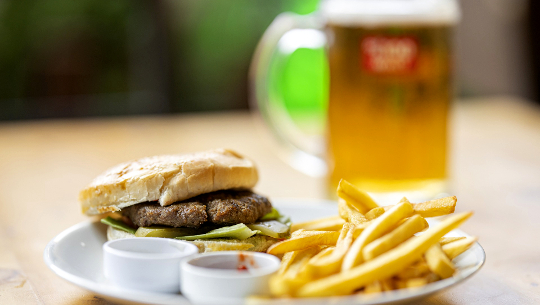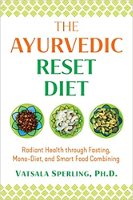
Image by Engin Akyurt
A city-based lifestyle promotes a phenomenon called “eating out.” People eat out for various reasons. They get tired after work and have no interest, time, or energy to cook their own food, so they spend their extra cash on restaurant foods. They may also feel too lazy to shop for groceries; carry the bags home; put the food away in their pantry; cut, chop, mince, slice, and clean the various ingredients; and do whatever else is required for food preparation.
There are many restaurants out there, and they serve food in every price range and from every continent on earth, so they provide the appearance of diversity and a feeling of cosmopolitan sophistication. People who know nothing about India or the spices that grow there can enjoy a curry dish. And Indians who do not know much about China can enjoy a dish of dim sum, wonton soup, or Kung Pao chicken.
Because restaurants cook and serve food for our taste buds and not for our health, they use refined ingredients, colors, preservatives, salt, sugar, and fat in the maximum amount necessary for great taste. Their foods, to some people at least, look and taste better than home-cooked foods.
The ambiance and décor of restaurants are designed to whip up an appetite, and the waiters serve food with good manners and decorum (at least in high-end restaurants). This gives the diners an experience of novelty, class, opulence, and luxury. With a little bit of extra cash on hand, they can get all of these, so why struggle to cook at home and bother with cleaning the dishes afterward?
Get The Latest By Email
Restaurant Habits Of Americans
Here are some survey statistics on the restaurant habits of Americans:
• 25 percent regularly dine out in coffee shops
• 20 percent visit a quick-service restaurant once a week
• 20 percent visit a full-service restaurant once a week
• 11 percent eat out with friends once a week
• 9 percent eat out with family once a week
• 8 percent eat out with a partner once a week
• 10 percent eat out alone once a week
Eating out, then, is a major modern pastime, and it is completely divorced from the concept of seasonality and eating for good health. This phenomenon is based on available cash, a lack of time, interest, energy, and space for cooking wholesome foods at home, and the desire to dress up and sit in a comfortable, stimulating restaurant setting and be served by waiters without having to clean the kitchen or do any dishes afterward.
However, in my childhood in India in the 1960s, restaurants were few and far between. People ate whatever their grandmother, mother, and aunts cooked at home. In my community, eating out was not even considered kosher because profit-driven restaurants paid the least amount of attention to Ayurvedic principles for cooking food. So we did not eat out.
All our fruits and vegetables were grown by our family in our own kitchen garden, our staples were sourced from local farmers, and our dairy came from a couple of our own cows. We ate vegetarian food and had no need for eggs, poultry, meat, or seafood. Every food item was sourced from within a hundred miles of where we lived.
The High Price of Eating Out
One popular fast-food restaurant is McDonald’s, where many diners order hamburgers in various sizes, including the Big Mac. This meal is available 365 days a year in McDonald’s locations all over the world and is so popular that Americans coined the phrase “Big Mac attack,” meaning that the desire to eat a Big Mac has taken over their mind—has attacked them—and now they must find the nearest McDonald’s so they can eat one.
Here is a list of ingredients in the bun alone:
Enriched flour (bleached wheat flour, malted barley flour, niacin, reduced iron, thiamin, mononitrate, riboflavin, folic acid), water, high fructose corn syrup and/or sugar, yeast, soybean oil and/or canola oil, contains 2% or less of the following: salt, wheat gluten, calcium sulfate, calcium carbonate, ammonium sulfate, ammonium chloride, dough conditioners (may contain one or more of the -following: sodium stearoyl lactylate, datem [diacetyl tartaric acid of esters of mono and diglycerides], ascorbic acid, azodicarbonamide, mono- and diglycerides, ethoxylated monoglycerides, monocalcium phosphate, enzymes, guar gum, calcium peroxide), sorbic acid, calcium propionate and/or sodium propionate (preservatives), soy lecithin.
Instead of using all these ingredients, simple buns can be made at home with flour, salt, yeast, and water. The extra chemical ingredients are not needed by your body and can actually be harmful. Take, for example, just a few of the items from the list:
• Ammonium chloride—Used in making fireworks, safety matches, and contact explosives. This chemical is on the New Jersey Department of Health’s “Right to Know Hazardous Substance List.” It can irritate the skin, nose, throat, and lungs; damage the eyes; and cause asthma and like allergies, and it may affect the kidneys as well.
• Ammonium sulfate—Used most commonly as a fertilizer for alkaline soils. It’s also in flame-retardant materials. Ammonium sulfate activates yeast, so it helps to get industrially produced bread to rise. This chemical can irritate the skin, eyes, and respiratory system and is deemed harmful if swallowed.
• Soybean and/or canola oil—Most likely made from genetically modified seeds, which animal studies indicate are harmful to humans indicated in toxic reactions in the digestive tract, liver and other organ damage, reproductive failure, infant mortality, immune reactions, and allergies. In addition, these oils release cancer-causing free radicals under high heat and the refining process they go through involves either very high temperatures or damaging chemicals. Soybean oil has also been linked to metabolic and neurological conditions.
• High fructose corn syrup—Used in almost all processed foods, so it is hard to avoid, but it is very harmful. It is found to cause inflammation, obesity, diabetes, heart diseases, and cancer.
• Enriched flour—“Enriched” means that all the nutrition was taken out and then some of it was added back in chemical form. Refined flours digest very rapidly so you feel hungry more quickly, and because all fiber is removed, the refined flour, though “enriched,” does not move easily through the intestines, which often leaves you constipated.
Many of the rest of the ingredients in the bun are also detrimental to health, and the hamburger, onion, cheese, lettuce, and pickle used for assembling the meal are mass produced using chemical fertilizers, pesticides, herbicides, artificial colors, harmful hormones, and so on. They are transported thousands of miles and come to us unfit for human consumption.
The Origin of the Food We Eat
Please note that the list of ingredients does not disclose their places of origin, but we can make an educated guess. Wheat for the bun is quite likely grown in China, and the buns are probably also made in a bun factory in China. Cattle are raised in Brazil. Potatoes are grown in Idaho. Soybean oil and lard come from Vietnam where rain forests have been decimated to make room for growing genetically engineered soybeans and housing pig factories. Sugar is from Brazil, salt from the Netherlands, and water for making Coca-Cola from the ground waters in rural India.
America supplies all the chemical fertilizers, genetically engineered seeds, preservatives, pesticides, insecticides, artificial colors, antibiotics, and whatever else is needed in producing, distributing, and marketing this toxic meal to every country in the world. Is this real food? Is it local? Is it seasonal? Which hunter-gatherer or subsistence-farming tribe could have imagined that one day their descendants living and working in the city would be paying to purchase this garbage that is sold as food?
To summarize, the modern phenomenon of a city-based lifestyle relies completely on the highly processed, industrially manufactured food sold in the supermarkets. The food is always the same, irrespective of the season, and it is usually grown thousands of miles away from where it is eaten. The steep price we have paid for this reliance is the loss of fresh, delicious, and nutritious seasonal food and with it, the loss of prana (energy), vitality, and overall good health.
For these reasons alone, the simple Ayurvedic technique of fasting to reboot our body (after years of ingesting faulty food), eating one type of simple food at a time, and then combining compatible foods in a sensible manner becomes a must for our well-being. You can learn facts to enable you to make better decisions about the food you choose to eat.
Copyright 2021 by Vatsala Sperling. All Rights Reserved.
Reprinted with permission of the publisher,
Healilng Arts Press, an imprint of Inner Traditions Intl.
www.innertraditions.com
Article Source
The Ayurvedic Reset Diet: Radiant Health through Fasting, Mono-Diet, and Smart Food Combining
by Vatsala Sperling
 In this easy-to-follow guide to Ayurvedic dietary resets, Vatsala Sperling, Ph.D., details how to rest and gently cleanse your digestive system, lose extra pounds, and reboot your body and mind with the Ayurvedic techniques of fasting, mono-diets, and food combining. She begins by sharing a simplified introduction to the healing science of Ayurveda from India and explains the spiritual, mindful relationship to food at its heart. Offering step-by-step instructions for a full 6- or 8-week Ayurvedic reset diet, as well as a simplified 1-week program, she details, day by day, what to eat and drink and provides recipes and meal prepping tips and techniques.
In this easy-to-follow guide to Ayurvedic dietary resets, Vatsala Sperling, Ph.D., details how to rest and gently cleanse your digestive system, lose extra pounds, and reboot your body and mind with the Ayurvedic techniques of fasting, mono-diets, and food combining. She begins by sharing a simplified introduction to the healing science of Ayurveda from India and explains the spiritual, mindful relationship to food at its heart. Offering step-by-step instructions for a full 6- or 8-week Ayurvedic reset diet, as well as a simplified 1-week program, she details, day by day, what to eat and drink and provides recipes and meal prepping tips and techniques.
For more info and/or to order this book, click here.
About the Author
 Vatsala Sperling, Ph.D., PDHom, CCH, RSHom, is a classical homeopath who grew up in India and earned her doctorate in clinical microbiology. Before moving to the United States in the 1990s, she was the Chief of Clinical Microbiology at the Childs Trust Hospital in Chennai, India, where she published extensively and conducted research with the World Health Organization. A founding member of Hacienda Rio Cote, a reforestation project in Costa Rica, she runs her own homeopathy practice in both Vermont and Costa Rica.
Vatsala Sperling, Ph.D., PDHom, CCH, RSHom, is a classical homeopath who grew up in India and earned her doctorate in clinical microbiology. Before moving to the United States in the 1990s, she was the Chief of Clinical Microbiology at the Childs Trust Hospital in Chennai, India, where she published extensively and conducted research with the World Health Organization. A founding member of Hacienda Rio Cote, a reforestation project in Costa Rica, she runs her own homeopathy practice in both Vermont and Costa Rica.








